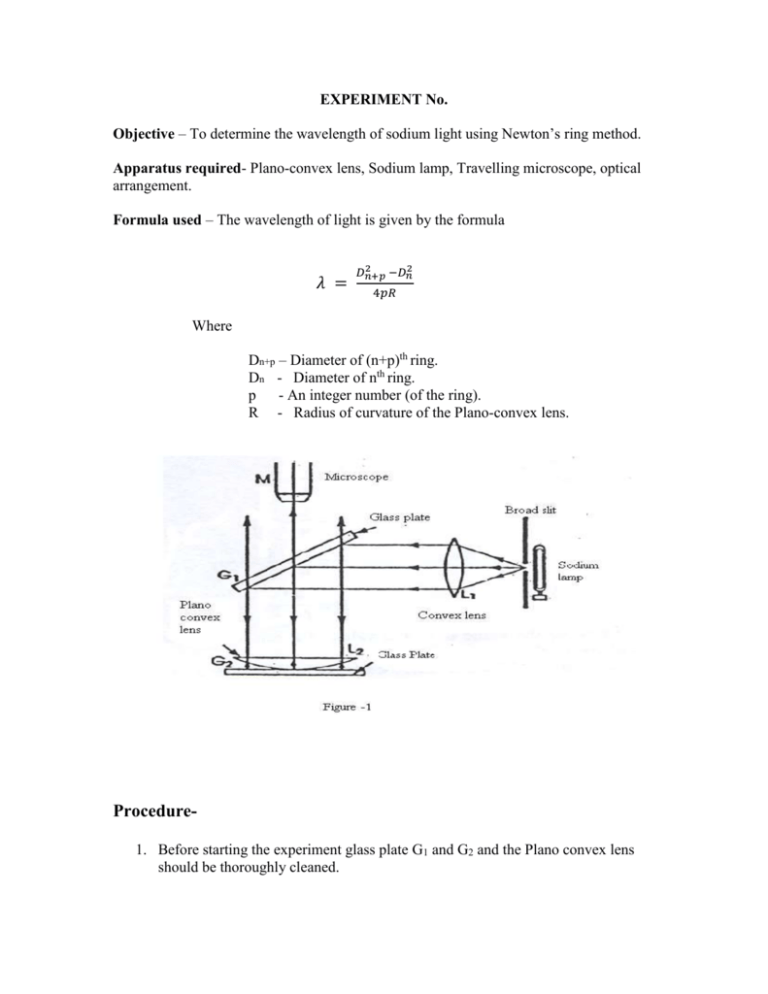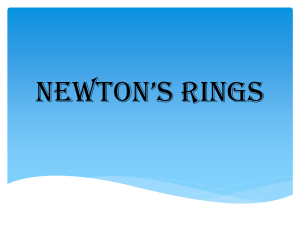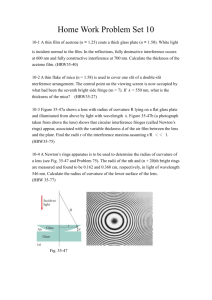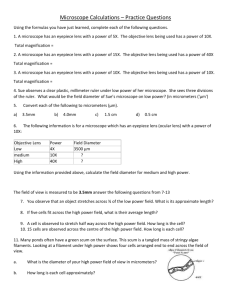Newtons ring experiment
advertisement

EXPERIMENT No. Objective – To determine the wavelength of sodium light using Newton’s ring method. Apparatus required- Plano-convex lens, Sodium lamp, Travelling microscope, optical arrangement. Formula used – The wavelength of light is given by the formula 𝜆 = 2 𝐷𝑛+𝑝 −𝐷𝑛2 4𝑝𝑅 Where Dn+p – Diameter of (n+p)th ring. Dn - Diameter of nth ring. p - An integer number (of the ring). R - Radius of curvature of the Plano-convex lens. Procedure1. Before starting the experiment glass plate G1 and G2 and the Plano convex lens should be thoroughly cleaned. 2. Put the Plano-convex lens (convex portion down) on the plane glass plate and set it as shown in fig-1. 3. Set the microscope near to the centre of Plano-convex lens, focus it on rings by moving the microscope in the vertical plane using pinion arrangement till the rings are seen quit bright and distinct. Clamp the microscope in the vertical plane. 4. According to the theory the centre of the interference fringes should be dark but sometimes the centre appears white. This is due to the presence of dust particles between Plano convex lens and plane glass plate. In this case the lens and plane glass plate should be cleaned again. 5. First fix the crosswire on the centre of the rings. Now, move the crosswire in a horizontal direction to one side of the rings pattern by using the screw attached for this purpose. Fix the crosswire on any ring (count the number) and note the position in the vernier attached. Now keep on moving the crosswire and take observations for different rings. Move on to the other side by passing the centre and take the positions of the same rings. Observations should be taken by moving the crosswire in only one direction to avoid pitch error. This is shown in fig 2. Now use this data to obtain the diameters of the different rings. 1. Fig.-2 The radius of curvature can be determine by using a spherometer.In this case 𝑅= 𝑙2 6ℎ + ℎ 2 Where; l is the distance between the two legs of spherometer as shown fig 3. h is the difference of the readings of the spherometer when it is place on lens as well as when laced on plane surface. Fig 3 Observations: Value of one division of the main scale = …….. cm. Number of division on vernier scale = …….. Least count of microscope = ………cm. S.No. Table for determination diameter D Micrometer reading Diameter Left end Right end (D)= M.S. V.S. Total M.S. V.S. Total (a~b) cm reading reading (a)cm reading reading (b) cm (D)2 11 9 7 5 3 1 S.No. Table for determination of R Spherometer reading Zero reading of plane surface (a) Reading on lens (b) M.S. V.S. Total M.S. V.S. Total h = (b-a) 1. 2. Distance between two legs of spherometer L= ……… cm Calculations The wave length of sodium light 𝜆 = 2 𝐷𝑛+𝑝 −𝐷𝑛2 4𝑝𝑅 = …………Å Radius of curvature of the lens 𝑅= 𝐿2 6ℎ + ℎ 2 = ……. Cm. The value of (D2n+p – D2n) can also be obtained using a graph as shown in fig 4 .The graph is plot between the square of diameter of the ring along Y- axis and the corresponding number of ring along X- axis. Mean h Fig 4 Result:. The mean wavelength λ of sodium light = …….. Å Standard mean wave length (5890 + 5896) / 2 = 5893 Å Percentage error = Standard value−Observed value Standard value ⤫ 100% Sources of error and precautions: 1. Glass plate and lens should be cleaned thoroughly. 2. Before measuring the diameter of rings the range of microscope should be properly adjusted. 3. Light should be properly focused on lens arrangement.








